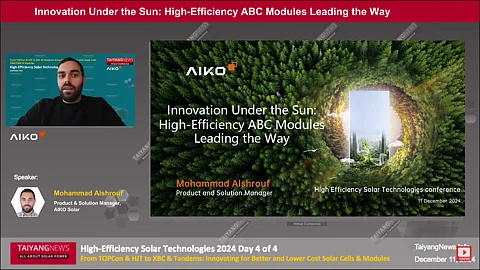

AIKO Solar recently unveiled its ABC INFINITY Gen III series module, featuring an efficiency of 25% and up to 20 W higher wattage
This module is expected to be launched by mid-2025
The next-generation ABC module's higher power wattage can be attributed to reduced non-cell surface area and incorporation of 0BB metallization
Compared to its peers with the same module area, the primary value proposition of back contact (BC) cell technology, such as higher power, improved aesthetic, and enhanced efficiency, can be further progressed with technological advancement at both cell and module levels. Having become the most sought-after technology for distributed generation (DG) applications, advancements in bifaciality – a major limitation of BC technology – are now making BC modules suitable for utility-scale applications as well.
At the recent TaiyangNews Annual Flagship Event – High-Efficiency Solar Technologies Conference 2024 – Mohammad Alshrouf, Product & Solution Manager at AIKO Solar, a pioneer in BC cell technology modules, delivered an overview of the latest BC module offerings and technological features (see AIKO Solar presentation here). The company, with multiple manufacturing facilities in eastern China and 3 R&D labs in China and Europe, has shipped more than 150 GW of modules globally.
Starting with the development of p-type cell technology between 2016 and 2019, the company ventured into BC cell technology in 2021, followed by the development of n-type All Back Contact (ABC) technology. With mass-scale cell efficiency reaching up to 27% in 2023, AIKO Solar developed modules with efficiencies exceeding 24%. This ABC module, boasting more than 24% efficiency, held the top position in the TaiyangNews TOP SOAR MODULES ranking for 20 consecutive months in 2024, says Alshrouf.
Leveraging the high efficiency and power of ABC cells, the company offers ABC modules for various application scenarios in different sizes: the Neostar Series (1,757 x 1,134 mm) for residential applications; the C&I-scale Comet and Nebular Series (2,382 x 1,134 mm and 1,762 x 1,134 mm, respectively); and the utility-scale Steller Series (2,382 x 1,134 mm). These models are ABC Gen II products, according to Alshrouf. In 2024, with further advancements in ABC cell technology, the company achieved up to 27.5% mass-scale cell efficiency, which is reflected in the latest ABC Gen III - INFINITY Series ABC module, boasting an efficiency of up to 25%.
Regarding the features of the ABC Gen II module, Alshrouf began by discussing the power gain from the same module area compared to the standard TOPCon module. By leveraging the higher power gain from the BC cell structure’s front-side metal gridline-free architecture, the C&I and residential ABC Gen II modules, with dimensions of 1,757 x 1,134 mm, deliver up to 20 W of additional power. In contrast, the utility-scale ABC Gen II modules, sized at 2,382 x 1,134 mm, boast up to 35 W of additional power, added Alshrouf. To mitigate potential power loss from localized or partial shading, the ABC cell, with partial shading optimization capabilities, can produce 30% more electricity than a standard TOPCon module, even when a complete cell is fully shaded. This has been validated by the TÜV NORD test report, noted Alshrouf. In multiple pilot projects across various locations in China, AIKO Solar’s ABC module demonstrated higher power generation – ranging from 4.94% to as much as 50% – under shading from obstacles, trees, or dust, compared to the standard TOPCon module. Additionally, the lower power temperature coefficient of -0.26%/°C, compared to the TOPCon module's -0.29%/°C, results in up to a 1.7% higher power gain at an 80°C operating field temperature, explained Alshrouf.
Regarding reliability, the ABC module’s maximum cell operating temperature of up to 100°C compared to the TOPCon module’s 170°C exhibits enhanced fire safety and longer durability. Furthermore, the BC module, featuring cells with both positive and negative metal contacts on the rear side, demonstrated a reduced probability of module failure due to cell cracks under high external mechanical stresses, as internal tests showed. The ABC module, with a lower year-on-year linear degradation rate of 0.35% compared to the 0.4% of its TOPCon counterpart, followed by a 1% degradation in the first year, retains up to 88.85% of its power output at the end of a 30-year full lifecycle, compared to 87.40% for the TOPCon module.
The latest AIKO INFINITY Gen III series ABC module, sized at 1,762 x 1,134 mm, delivers up to 20 W of additional power output compared to its predecessor. This power gain can be attributed to several new features, including increased cell efficiency and a reduction in the non-cell area of the module. To enhance the cell coverage ratio, the company has moved its 3 current collectors to the back side, which increases the active cell area by up to 1.1%, resulting in a power gain of up to 8 W. The ABC overlap welding with zero cell-to-cell spacing technology offers up to 0.5% more generated area compared to traditional ‘Z’-shaped welding technology, surpassing even ECA technology-based shingled cell designs, as shared by Alshrouf. Additionally, the successful incorporation of busbarless (0BB) metallization over the ABC cell improves power generation per square meter by reducing electrical losses. According to Alshrouf, this latest ABC Gen III module series is expected to be available by middle of 2025.
